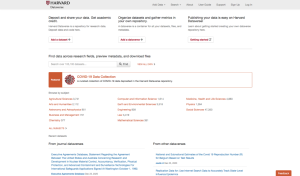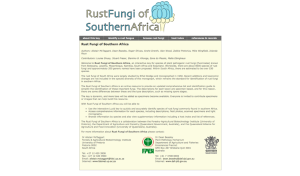General Interest
Back to Top
|
 |
|
Harvard Dataverse
|
Science |
|
Researchers looking for a reliable data repository may enjoy Harvard Dataverse. The platform is free and open, welcoming researchers from across disciplines (in and beyond Harvard) to share and store data. Contributors have the option of making their data available to the general public or restricted to select groups, though users should note that "metadata is open and findable via search engines, even when the data are restricted." To begin, follow the "Getting Started with the Harvard Data Repository" link on the About page. The introductory video on the About page also provides a quick but comprehensive overview of the platform's benefits and highlights its implementation of the FAIR data principles ("findable, accessible, interoperable, and reusable,"). The User Guide (found in the top menu bar) is another great resource for those new to the site. Readers who are not conducting research themselves can still browse the site to see what has been published. The main page organizes data by subject area, allows for personalized searches, and promotes a featured data set. Currently, the site is highlighting its COVID-19 Data Collection. [EMB] |
|





|
|
 |
|
Coffee and Books Podcast
|
Language Arts |
|
Launched this past summer, Coffee and Books is the perfect show for bibliophiles to cozy up with this winter. Marc Lamont Hill hosts the show, bringing his expertise as an author, scholar, and bookstore owner. His store, which is part coffeeshop and part bookshop, is named Uncle Bobbie's Coffee & Books (physically located in Philadelphia). The store's slogan, "Cool People, Dope Books, Great Coffee" matches the energy of the show. The "coffee" part of the podcast is not just charming imagery nor a play on the name of his shop; Hill starts each episode by asking his guests what they are drinking. This provides an unique introduction to each personality before diving into their work. Then, the podcast takes the shape of a virtual book club, as Hill engages guests in conversations about reading, writing, and social commentary. For example, episodes have included a lively review of former President Barack Obama's memoir (see the November 23, 2020 episode) and a discussion on abolitionist teaching and Black joy with professor and writer Bettina Love (see the October 19, 2020 episode). A new installment drops each week, so readers should check their preferred podcast platform often for the latest. [EMB] |
|





|
|
 |
|
She Changed the World: North Carolina Women Breaking Barriers
|
Social studies |
|
North Carolina's Department of Natural and Cultural Resources created "She Changed the World" to both celebrate the centennial anniversary of the 19th Amendment and acknowledge ongoing struggles for equity today. The exhibition takes many forms, but users will likely want to begin with the embedded slideshow (found under "Online Exhibit"), which details the women's suffrage movement and ratification process, while also highlighting some failures of movement. For example, many branches of the movement excluded women of color, and even after the 19th Amendment's ratification, many women of color were barred from voting. Activists like Dr. Charlotte Hawkins Brown and Ella Baker led the charge for voting rights through a racial justice lens, culminating with the passing of the Voting Rights Act in 1965 (prohibiting racial discrimination in voting practices). Many other parts of the traveling exhibition are also viewable online. This includes "She Changed the World: A Health Perspective," which discusses gender identity, autonomy, and wellness. Plus, educators will find a guide with more than 40 pages of classroom activities, and North Carolina residents can learn more about the "She Changed the World" oral history project. To share responses to the exhibition, or view additional online content, readers can use the hashtags #SheChangedtheWorld and #NCHerstory on their social media networks. [EMB] |
|





|
|
 |
|
 |
|
Breakthrough Toolkit
|
Health |
|
Jim Allison: Breakthrough tells the story of Allison, the 2018 Nobel Prize in Medicine winning scientist, and his "stubborn [and] visionary quest to find a cure for cancer." While the general public will need access to select streaming services (such as Amazon Prime Video or PBS Passport) to view the film, educators can fill out a short form to gain free access. In addition to the film, educator's can implement the Educator Toolkit. This is a great classroom resource to engage students in discussions about science and perseverance; as biology professor Maia Larios-Saiz, PhD notes, "this film will inspire your students and foster discussion not only about the science behind immunotherapy against cancer, but also about the process of science as a human endeavor and how dreaming big and working hard pays off in the end." The toolkit splits the film into three segments (Introduction to Cancer, The Immune System, and From Discovery to Rollout) with a unique lesson plan for each, allowing it to be easily divided between class periods. Plus, educators have access to bonus materials including a glossary, summary worksheet (that doubles as both a movie guide and "pop quiz"), discussion guide, and activities that profile various STEM career paths. The toolkit is sponsored by Dragonfly Therapeutics and Skyhawk Therapeutics. [EMB] |
|





|
|



















